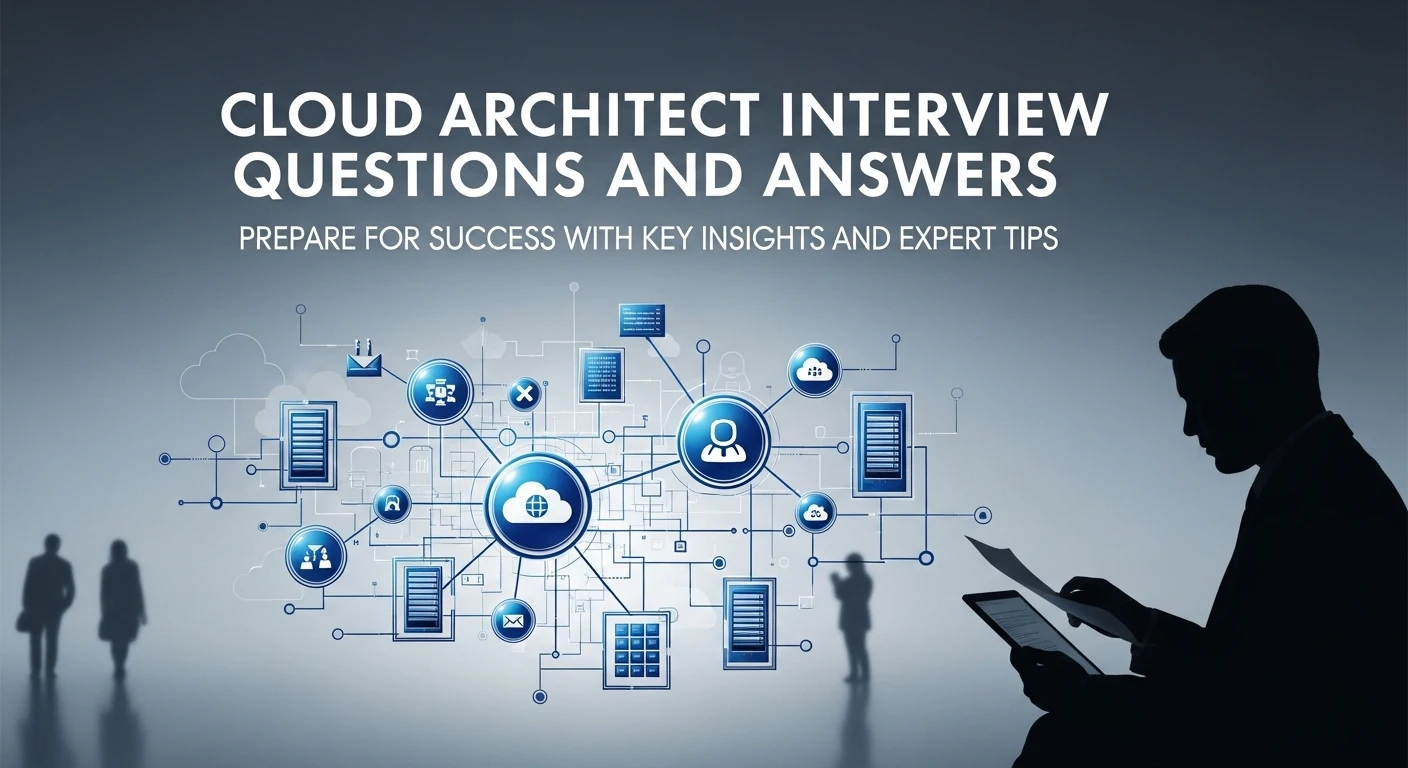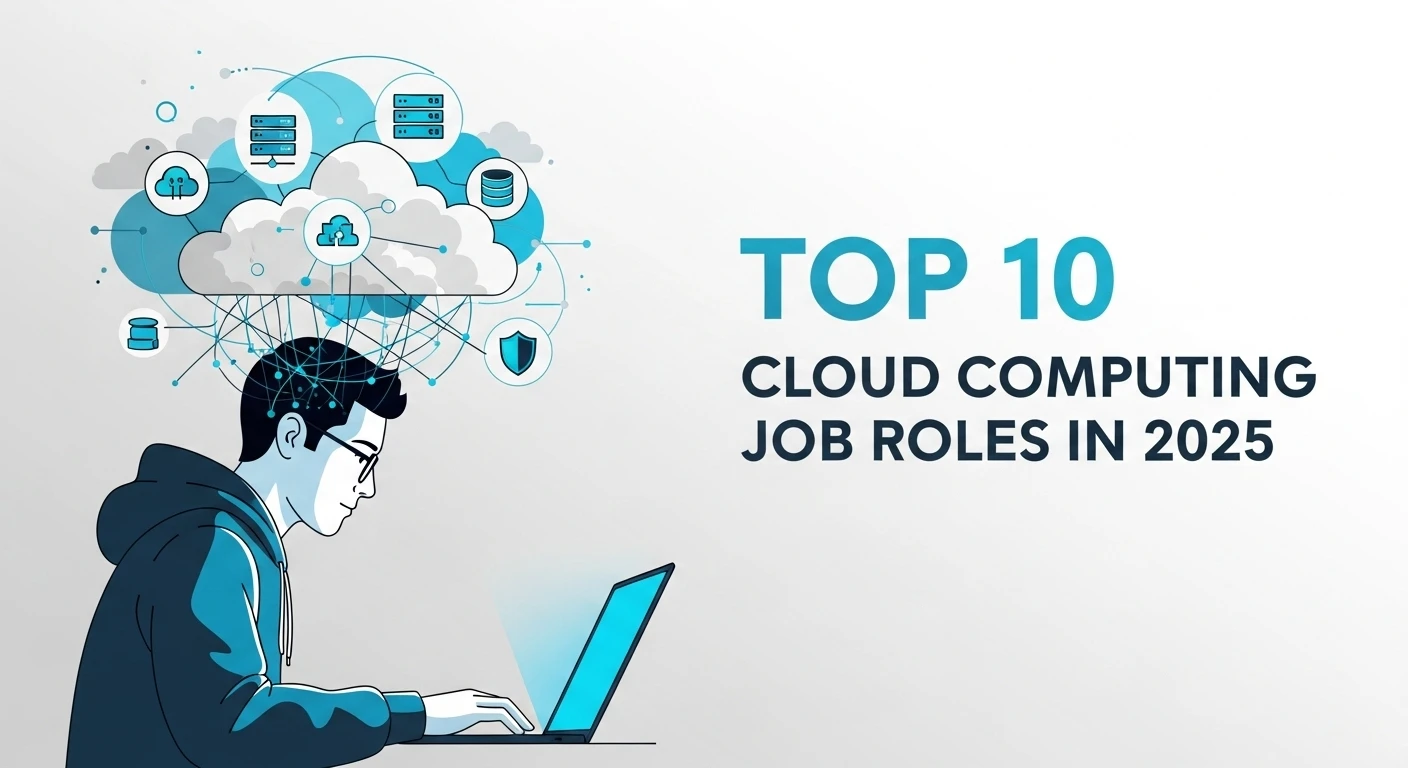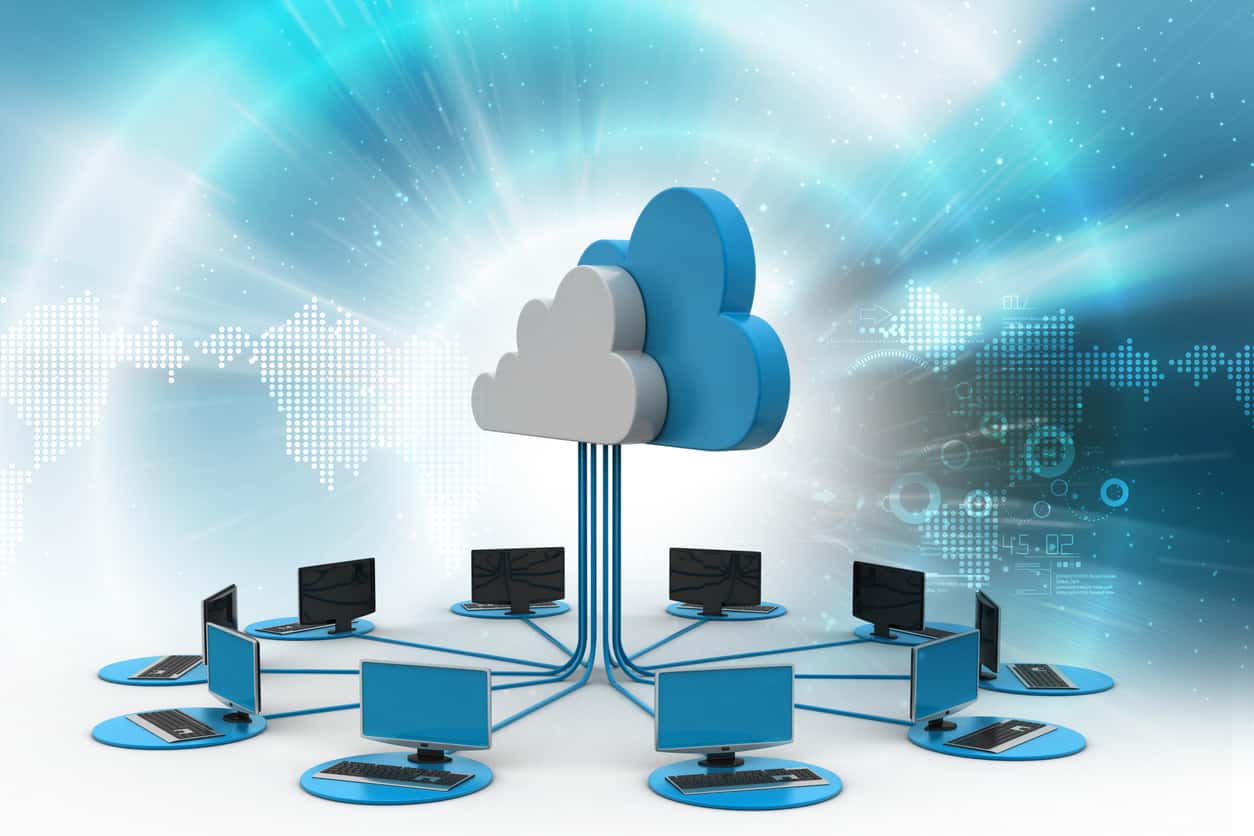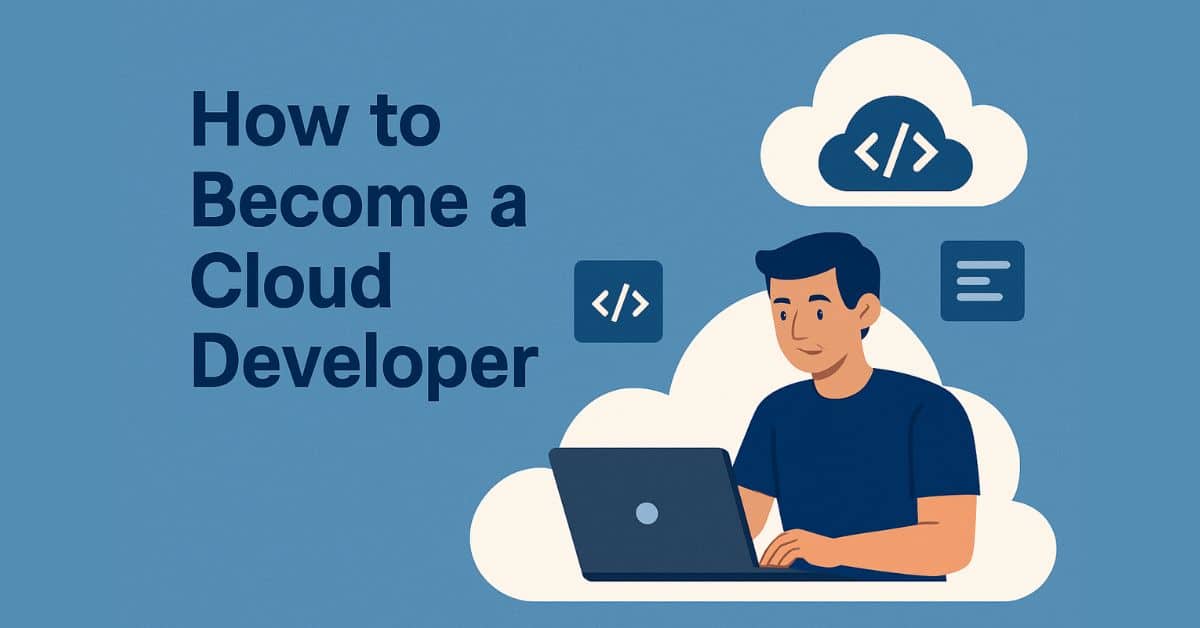A cloud architect is a professional who designs, builds, and manages a company's cloud system. This means that if all the company's data, applications, and servers run on the cloud, then this person is responsible for setting it up and maintaining it properly.
To do this job, you must have a deep understanding of cloud computing. Also, you should have a good knowledge of things like services, security, cost management, and system design of different cloud service providers (such as AWS, Azure, Google Cloud).
In this guide, you will find important questions and answers asked in a cloud architect interview.
Whether you are preparing for an interview or just want to strengthen your knowledge, these questions and answers will help you become an expert in every important topic.
We have designed this guide in the following way:
- You will start with basic knowledge (like what a cloud is, what cloud models are, etc.)
- Then you will learn advanced concepts, like architecture design, high availability, security, and scalability
- And finally, we will talk about real-world situations — that is, how decisions are made in real projects
After reading this guide, you will not only be interview-ready, but you will also have a complete understanding of cloud architecture.
PG in Cloud Computing With AI Skills
Learn AWS, Azure & GCP with 80+ projects, 120+ services, expert mentorship & career support. Now with Applied AI on Cloud!
Basic understanding and concepts
1. What is the difference between Public, Private, and Hybrid Clouds?
Public Cloud
In this, cloud service is provided on the Internet through a third-party company (such as AWS, Google Cloud). Many companies can use the same service.
- Advantages: Cheap, scalable, gets set up quickly.
Private Cloud
This is created separately for a single organization. The company can manage it itself or get it done by a provider.
- Advantages: More secure, complete control.
- Disadvantages: It is expensive.
Hybrid Cloud
This is a combination of both public and private clouds. Sensitive data can be kept in a private cloud and the rest in a public cloud.
- Advantage: Both flexibility and cost-saving are available.
2. What are the advantages of using cloud services, compared to traditional (on-premise) systems?
- Low cost – No need to buy hardware. Pay as much as you use.
- Scalability – You can increase or decrease CPU, RAM etc. as per your requirement.
- Reliability – Automatic backup, disaster recovery etc. are already there to avoid data loss.
- Global reach – You can run applications in any country.
- Security – Big cloud providers (like AWS, Google) install very high-level security, which a small company cannot install on its own.
- Start working quickly – the server can be live in 5 minutes, very easy to deploy.
3. What are the main parts of Cloud Architecture?
- Compute – VMs (Virtual Machines), Containers (like Docker), Serverless functions (like AWS Lambda)
- Storage – Object storage (S3), Block storage, File storage, Databases
- Networking – VPC (Virtual Private Cloud), Load Balancer, Subnets, Gateways, DNS Services
- Security – IAM (Identity and Access Management), Firewalls, Encryption
- Monitoring & Management – Tools like CloudWatch, StackDriver that track performance and logs
- Automation – Infrastructure as Code tools (like Terraform, AWS CloudFormation)
4. What is the difference between Cloud Security and Traditional IT Security?
Cloud security works on a Shared Responsibility Model.
- The cloud provider is responsible for keeping the cloud infrastructure secure. That means physical servers, networks, data centers, and hardware.
- The customer (that is, us) is responsible for keeping the things inside the cloud secure, such as data, operating system, applications, and network configuration.
On the other hand, in traditional IT security, we ourselves manage and secure the entire system (including physical servers and the network). That means everything is our responsibility.
5. What is Virtualization in Cloud, and why is it important?
Virtualization means creating a virtual version of a resource (such as a server, storage, or network).
This is very important in the cloud because:
- Many virtual machines (VMs) can run on one physical server.
- This makes better use of hardware.
- Different users can share the same physical system (which is called multi-tenancy).
Simply put: fewer machines give you more work and flexibility.
Knowledge of cloud providers and platforms
6. What are AWS, Azure, and Google Cloud? What is the difference between them in terms of service, performance, and price?
AWS (Amazon Web Services):
This is the biggest player in the cloud world. It has the most and oldest tools and services. That means if you need a lot of technical things and you can handle a little complex things, then AWS is great.
Learn AWS Cloud fundamentals and gain hands-on experience in deploying, managing, and scaling applications on AWS.
Azure (Microsoft Azure):
If your company is already using Microsoft things (like Outlook, Windows Server etc.), then Azure is a good choice. It provides very good integration at the enterprise level and also works well in hybrid cloud.
Build essential Azure skills for cloud engineers, DevOps professionals, and IT administrators. Learn to create virtual networks, deploy virtual machines, and secure cloud storage.
Google Cloud (GCP):
Google's platform is best for those who want to do something big in data analytics, machine learning, or AI. Google's global network speed is also very fast and optimized.
7. What are the most used services of AWS?
- EC2 (Elastic Compute Cloud): It provides virtual servers in the cloud. you can choose CPU and RAM as per your requirement.
- S3 (Simple Storage Service): It is a scalable storage. You can store files, backups, documents and static websites in it.
- Lambda: It is a serverless service — you write code, and it will run on the backend without setting up a server. Best for event-based automation.
8. What are Regions and Availability Zones in the cloud?
Region:
A geographical location where the cloud provider has set up multiple data centers. Each region is physically different from each other.
Availability Zones (AZs):
There are smaller zones within a region, which are separate with their own power, cooling and network. This means that if there is a problem in one zone, the other zone is not affected by it.
Why are these important?
When you deploy an app in more than one AZ, it becomes more secure, available and crash-resistant.
9. Which should you choose for a project – AWS, Azure or GCP?
This choice depends on many things:
- Existing System: If the company is already dependent on Microsoft, then Azure will fit.
- Special needs: If you want to do heavy analytics or machine learning then GCP will be best. For general-purpose or if variety is needed then AWS is the most versatile.
- Cost: Compare the price of each service. See how much the total cost will be on which platform.
- Knowledge of the team: Which provider's knowledgeable team you have is a big factor.
- Compliance: Security or legal compliance is necessary in some industries then see which provider provides those certifications.
10. What is the role of load balancing in the cloud? And which services provide it?
A Load Balancer divides incoming traffic between different servers so that:
- High Availability: If a server is down, the traffic is sent to another healthy server.
- Scalability: When more people open the site, more servers are added. If there is less traffic, they are reduced.
- Better Performance: There is no excessive load on a single server.
Services:
- AWS: ELB (Elastic Load Balancer), ALB, NLB, GLB
- Azure: Azure Load Balancer, Application Gateway, Traffic Manager
- GCP: Cloud Load Balancing
11. How do Cloud Providers handle High Availability and Disaster Recovery?
For High Availability:
- Redundancy: The same app is deployed in more than one AZ.
- Load Balancing: Users' traffic is sent to healthy instances.
- Auto Scaling: If traffic increases, new instances are added, if it decreases, they are removed.
For Disaster Recovery:
- Backup and Restore: Data is regularly backed up in a different region.
- Multi-Region Deployments: A standby version of the app is kept active in another region.
- Failover Automation: If one region fails the system automatically activates the other region.
Design and Architecture (Cloud)
12. What is the role of a Cloud Architect when building a scalable and fault-tolerant cloud system?
A Cloud Architect is the person who maps out the entire cloud infrastructure. His job is not just to choose servers, but to make sure that everything runs smoothly, doesn't break down, and doesn't cost too much money. This includes:
- System Design: Deciding which compute, storage, or networking service is best.
- Scalability: When traffic increases, the system automatically adds more machines (auto-scaling), divides traffic (load balancing), and is divided into smaller parts (microservices) so that each part can scale separately.
- Fault Tolerance: If one part fails, the system can still run — for this, data and servers are spread across different Availability Zones.
- Cost Optimization: Choosing resources according to need and using pricing plans wisely.
- Security & Compliance: Keeping data and systems safe, and also following rules and regulations.
Read: How to Become a Cloud Architect?
13. Has there ever been a time when you had to build architecture with high availability and redundancy? How did you do it?
Before answering this question, it is important to give the interviewer a specific real-life example. But the approach can be something like this:
- Requirements Gathering: First understand how soon the business needs the system back (RTO) and how old the data will be (RPO).
- Multi-AZ Deployment: Application deployed in at least two Availability Zones.
- Load Balancer: To distribute traffic equally and remove unhealthy instances.
- Auto Scaling: If the number of users increases, servers also increase automatically.
- Data Redundancy: Database replicated (eg AWS RDS Multi-AZ) and static data kept in redundant storage (eg AWS S3).
- Monitoring: A system to catch every fault with the help of alerts and logs.
14. If the application is global and users are all over the world, how will you design the architecture?
- Global Load Balancer: Like AWS Global Accelerator, so that the user can be connected to the nearest region.
- Multi-Region Deployment: Deploying the application in different regions so that latency is reduced.
- CDN (Content Delivery Network): Like CloudFront – static content gets cached near the user so that it does not have to be taken from the server every time.
- Global Database: Like Amazon Aurora Global or Azure Cosmos DB – so that all users get fast and synced data.
15. How do you manage data consistency and synchronization in the Cloud?
- Databases: Where strict consistency is required, there is a relational DB (like PostgreSQL), and where there can be a little delay, there is NoSQL (like DynamoDB).
- Replication: Copying data to different AZs or regions.
- Eventual Consistency: This is normal in distributed systems – updates happen first in one place and gradually get synced to other places.
- Messaging Queues: Such as SQS, Kafka or RabbitMQ – so that data processing is asynchronous and there is no tight coupling.
16. What are Microservices and what are their advantages?
Microservices are an architectural style in which the application is divided into small parts (services). Each service does a specific task and is loosely connected to the rest.
Advantages:
- Agility: Different teams can work on different services, without disturbing each other.
- Scalability: Scale only the service that is needed, not the whole app.
- Resilience: If one service fails, the whole app will not fall.
- Tech Diversity: Different languages, databases or frameworks can be used in each service.
17. What should be kept in mind while designing cloud storage?
- Data Tiering: Like S3 Standard for frequently accessed data, Glacier for rarely accessed — to save cost.
- Encryption: Encrypt data in transit (while running) and at rest (when stored).
- Access Control: Manage access with IAM policies and bucket policies.
- Lifecycle Policies: Create rules to automatically delete or archive old data.
- Backup & Recovery: Have a solid backup plan and test it.
- Data Consistency: Understand the consistency model of storage service (eventual vs strong) and design the app accordingly.
Security and Compliance – Interview Questions and Answers
18. What steps will you take to keep your Cloud Infrastructure secure?
- IAM (Identity and Access Management): First of all, follow the least privilege principle — meaning, give each person only the permissions they really need.
- Encryption: Data should be encrypted both when stored (at rest) and when transferred (in transit). So that no one can intercept it.
- Network Segmentation: Divide the network into parts using VPCs and Subnets. This will ensure that if something goes wrong in one part, the other part will remain safe.
- Monitoring & Auditing: Keep logs running, install monitoring tools — so that any suspicious activity can be caught.
- Regular Audits: Conduct security audits and penetration testing every few minutes, so that you can catch the problem before it happens.
- Security Posture Management (CSPM): Deploy tools that continuously check misconfigurations in your cloud — like is the bucket public?
- Patch Management: The system should not be outdated. Keep updating and patching everything from time to time.
19. How do you follow rules like GDPR, HIPAA, SOC 2 in the cloud?
- Understand the Shared Responsibility Model: First of all, make it clear which responsibility is yours and which is the cloud provider's.
- Choose a Certified Cloud Provider: The provider which is already certified for these rules — like AWS, Azure, GCP etc.
- Use encryption correctly: Always keep sensitive data encrypted — whether in storage or in transfer.
- Access Control: Through IAM policies, decide who can access sensitive data.
- Auditing & Logging: Log every activity — who is accessing the data, who is changing what.
- Data Residency: Store data in Europe (or wherever required) for GDPR. Follow country-wise rules.
20. How do you encrypt data at rest and in transit in the cloud?
Data at Rest:
When data is in storage (e.g. S3, disk), then encrypt it with services like KMS (Key Management Service) or Azure Key Vault. Nowadays storage services also provide auto-encryption.
Data in Transit:
When data is going from one system to another, then use secure protocols like SSL/TLS. And if network-level security is required, then use VPN.
21. What are CSPM and CASB? How do they help in security?
CSPM (Cloud Security Posture Management):
These are tools that constantly check the cloud for any misconfigurations – public S3 buckets, open ports, incorrect IAM rules, etc.
CASB (Cloud Access Security Broker):
This is a security check-point between the user and the cloud provider. It protects against malware, performs DLP (Data Loss Prevention), and enforces policies.
Contribution:
- CSPM protects the infrastructure.
- CASB protects data and users.
- Together, these two cover the entire security strategy.
Cloud Cost Management and Optimization
22. What strategies will you use to optimize and reduce cloud costs for an organization?
- Right-Sizing: Always check how much a particular service or instance is being used. Resize resources that are underutilized or underutilized to the right size and type so that you only spend what you need.
- Elasticity: Use auto-scaling — this way resources increase when the load is high and decrease when the load is low. This helps you save on unnecessary costs.
- Reserved Instances or Savings Plans: If your workload is predictable (i.e. you know for how long you will need which resources), then buy reserved instances. This is much cheaper than on-demand.
- Spot Instances: For workloads that may stop occasionally (like testing or batch processing), use spot instances — they are quite cheap.
- Storage Optimization: Shift old data that is not accessed frequently to cheaper storage — like AWS Glacier, etc. Set lifecycle policies for this.
- Billing Alarms: Set alerts that ring when the expenditure exceeds a limit. This can help you avoid sudden high bills.
- Tagging: Tag every resource — like which team created it, which project it is for, etc. This will help you understand where and why the money is being spent.
23. How do you monitor and control cloud expenditure? Which other tools should you use?
Monitoring:
Each cloud provider offers its own monitoring tools:
- AWS: Cost Explorer
- Azure: Cost Management
- GCP: Billing Reports
These allow you to see a complete breakdown of daily, weekly, or monthly costs.
Control:
- Set budgets: Set budget limits in the cloud — and receive alerts when that limit is being approached or crossed.
- Cost Allocation Tags: Tagging each cost to categorize it — this will help you track how much is being spent on which team or project.
- Reserved Instances/Savings Plans: As mentioned above, buy these for long-term workloads to get cheaper rates.
Recommended Tools (which tools to use):
Cloud's own tools:
- AWS Cost Explorer
- Azure Cost Management
- Google Cloud Billing
Third-party Tools (if you need more detail):
- CloudHealth
- Apptio
Advanced Cloud Architect Topics
24. What is hybrid cloud architecture? What are the management, security and scalability problems in it?
Hybrid cloud means – some things are on your own (on-premise) server and some on the cloud (eg AWS, Azure). The whole system runs by combining both.
Challenges:
- Management: Managing two different systems simultaneously is a hassle. Tools and processes are different.
- Security: It is difficult to maintain the same security level.
- Scalability: It is not easy to scale applications from one place to another, especially when networking also has to be set up.
- Data Integration: Keeping the data same and synced in both systems is a big challenge.
25. How do you ensure fault tolerance and disaster recovery in a multi-cloud environment?
Solution:
- Standardization: Use Containers and Kubernetes so that the app runs the same in every cloud.
- Data Replication: Keep data copied in every cloud.
- Centralized Management: Manage resources uniformly across all clouds using tools like Terraform.
- Failover Automation: Set up a system that automatically switches to another cloud if something goes wrong.
- VPNs: Keep a secure VPN connection between clouds.
26. How do you automate scaling and provisioning in the cloud?
- Auto Scaling: As CPU usage increases or traffic increases — AWS Auto Scaling or Azure VMSS automatically add new servers.
- Auto Provisioning (IaC): With tools like Terraform or CloudFormation, the entire infrastructure is written in code. This makes the setup repeatable, version-controlled, and automatic.
27. How do you design a multi-region architecture for a mission-critical application?
There are two ways:
- Active-Active: Application is running in multiple regions simultaneously, and a global load balancer distributes the traffic.
- Active-Passive: Application is active in one region, and is backed up in another.
Important things:
- Global Database: Use a DB that is synced across regions.
- Data Synchronization: Use cross-region replication of AWS S3 or a custom solution.
- DNS Failover: Set up DNS in a way that if one region goes down, traffic is redirected to another.
28. How will you design a serverless architecture? What are its advantages and disadvantages?
Design:
- Event-Driven: The system starts working as soon as an event occurs (such as a photo upload to S3).
- FaaS: Break down small tasks into different functions using tools like AWS Lambda, Azure Functions.
- Managed Services: Get database, API, storage etc. from cloud managed services.
Advantages:
- No Server Management: No server hassle, cloud handles everything.
- Auto Scalability: If traffic increases, it scales automatically.
- Cost-Effective: Pay as much as you use.
Disadvantages:
- Cold Starts: If the function is sleeping, the first run can be slow.
- State Management: Managing state is a difficult task.
- Vendor Lock-in: Once it is built on a cloud, it can be difficult to move to another.
29. How do you manage configuration and secrets in cloud apps?
- Configuration: Keep all settings (like port number, feature flags) in tools like Git or AWS Parameter Store.
- Secrets: Never write passwords or API keys in code. Use AWS Secrets Manager or Azure Key Vault for this – which provides secure storage, rotation, and access control.
Situation-based and practical interview questions
30. If you are given the task of migrating an old on-premise application to the cloud, how will you do it?
Answer:
First of all, the application has to be properly assessed:
- Which systems is it connected to (Dependencies)?
- How much load does it bear (Performance)?
- How much data is there and where is it stored?
Then comes the "6 R's of Migration":
- Rehost (Lift and Shift): Moving the application to the cloud as it is. No change in the code.
- Replatform (Lift and Reshape): Using the benefits of the cloud by making slight changes. For example - using a cloud database.
- Refactor (Re-architect): Rebuilding the application - for example with microservices or serverless architecture.
- Repurchase (Drop and Shop): Drop the old system and buy a readymade SaaS solution.
- Retain: If necessary, keep some part on-premise.
- Retire: If an old system is no longer needed, remove it.
What else to do:
- First pick up a small, less-important app and test it (pilot project).
- Do data migration in such a way that downtime is minimal.
- Do cloud optimization after migration – so that performance, cost and security all three are better.
31. If the demand is sometimes low and sometimes very high, then how will you make the cloud architecture scalable?
Answer:
- Load Balancing: So that the load does not fall on a single server, divide the traffic among many servers.
- Auto Scaling: As soon as the load increases (eg CPU reaches 80%), new servers start automatically.
- Serverless Computing: Use serverless functions like Lambda — they scale automatically.
- Decoupling: Loosely connect services to each other — like by sending messages through SQS (queue). This does not overload the backend.
- CDN (Content Delivery Network): Cache static files near users to deliver them faster and reduce server load.
32. If you want to create an e-commerce website that handles sensitive customer data, how will you make the cloud infrastructure secure?
Answer:
- VPC and Subnets: Create a VPC with two subnets: Public (for web servers) and Private (for database and backend systems).
- Security Groups: Create security groups to control who can connect to whom. Only app servers can access the database.
- IAM (Identity and Access Management): Give each user or system only as much access as needed. Use roles, less passwords.
- Data Encryption: At rest (such as in a database), data should be encrypted. In transit (when data is being sent), use SSL/TLS.
- DDoS Protection and WAF: WAF protects against web attacks. DDoS protection will prevent the website from going down.
- Compliance: If there is credit card or payment data, then PCI-DSS compliance has to be taken care of.
33. How will you create a logging and monitoring system for a cloud app?
Answer:
- Centralized Logging: Collecting logs of all apps and servers at one place (such as AWS CloudWatch Logs, Splunk).
- Metrics Monitoring: Monitoring data such as CPU, RAM, Network usage of the server.
- Alerting: If a metric goes out of bounds (e.g. CPU > 90%), send an alert.
- Distributed Tracing: Use a tool like AWS X-Ray to find out where a request went in the backend and how long it took.
- Visualization: Use a tool like Grafana to create a dashboard that shows all logs and data at a glance.
34. How will you manage and orchestrate microservices in the cloud?
Answer:
- Containerization (Docker): Pack the app into small containers so that it becomes portable and scalable.
- Orchestration (Kubernetes): Use Kubernetes (AWS EKS, Azure AKS, GCP GKE, etc.) to manage and scale Docker containers.
- Service Mesh (Istio, Linkerd): To manage communication, security, and traffic between microservices.
- API Gateway: Use AWS API Gateway or Azure API Management to provide access to APIs to external users.
- CI/CD Tools: Automate the build-test-deploy process of microservices with Jenkins, GitLab CI/CD, AWS CodePipeline, etc.






